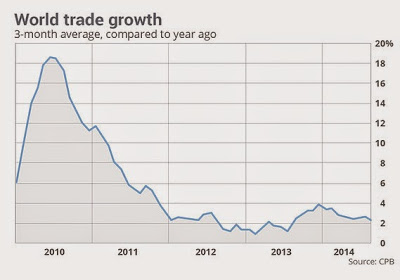This Great Graphic is from the Dutch Bureau of Economic Policy Analysis (CPB), and was posted by Steve Goldstein at MarketWatch. It shows the three-month average year-over-year growth rate of global trade.

The growth of trade slowed dramatically in from the second half of 2010 to the end of 2011. The pace of growth has steadied around 2% over the last thee years. Â
In the 90s and noughts, world trade grew faster than world growth. Over the two decades world trade grew by more than 5% a year. In part, subdued growth in trade in recent years reflects slower world growth. Last month, the World Bank cut its forecast for this year’s growth to 3.1% from 4.7%. World growth is expected to firm to 4% next year, not the 5.3% pace projected earlier this year.Â
Since the crisis, import growth has almost returned to pre-crisis levels in developing countries. Developed countries have not seen the same improvement, and this may relate directly to persistent weakness in much of Europe. Â
There are a few other factors, in addition to weaker growth in general, that may be dampening trade growth rates. The decline in commodity prices may be contributing to the recent weakness. The US and China external imbalances have shrunk, in line with the calls from the G20. Regional conflicts may also weaken trade flows. Over this period,. and as a consequence of the banking crisis, trade finance, typically a low margin business, has been squeezed. The 75% decline in Baltic dry shipping prices since the 2009 peak reflects the modest utilization of the substantial capacity.  Ironically the decline in the cost of shipping makes shipping good cheaper even as cross border movement of goods slowed. Â
It seems likely that there are cyclical and structural influences keeping the growth rate in trade subdued. The weak world growth and some weakness in prices appear to be significant factors. The reduction of US and China imbalances may play a role. In this context, we note that one of the reasons why some economists argue that Japanese exports have not picked up (in volume terms) despite the weakening of the yen is that Japan is moved production offshore.
Many of the Japanese cars on American roads were made in the US, for example. As we have noted before, the sales of affiliates of US multinationals outstrip exports from the US by a factor of more than 4. This speaks to an alternative to the traditional export-oriented strategy–a foreign direct investment strategy. We do not think this development is the major reason for the slowing of world trade growth. Yet the direct investment strategy should lessen fears that the slowing of the growth rate in world trade does not necessarily represent a move away from globalization.Â

